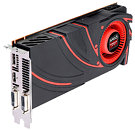- Joined
- Oct 9, 2007
- Messages
- 47,899 (7.37/day)
- Location
- Dublin, Ireland
| System Name | RBMK-1000 |
|---|---|
| Processor | AMD Ryzen 7 5700G |
| Motherboard | Gigabyte B550 AORUS Elite V2 |
| Cooling | DeepCool Gammax L240 V2 |
| Memory | 2x 16GB DDR4-3200 |
| Video Card(s) | Galax RTX 4070 Ti EX |
| Storage | Samsung 990 1TB |
| Display(s) | BenQ 1440p 60 Hz 27-inch |
| Case | Corsair Carbide 100R |
| Audio Device(s) | ASUS SupremeFX S1220A |
| Power Supply | Cooler Master MWE Gold 650W |
| Mouse | ASUS ROG Strix Impact |
| Keyboard | Gamdias Hermes E2 |
| Software | Windows 11 Pro |
AMD announced a new SKU to heat up the sub-$200 market segment, the Radeon R9 270. A slightly tuned down sibling of the Radeon R9 270X, the R9 270 is based on the 28 nm "Curacao" silicon, and features a similar core-configuration to it. The chip features the same 1,280 stream processor-count as the R9 270X, with 80 TMUs, 32 ROPs, and a 256-bit wide GDDR5 memory interface, holding 2 GB of memory, but features lower clock speeds, at 900 to 925 MHz core (PowerTune with Boost), and 5.60 GHz memory (GDDR5-effective), which churns out 179 GB/s of memory bandwidth. Its TDP is rated at 170W, and the card draws power from a pair of 6-pin PCIe power connectors. The GPU supports the latest APIs, including DirectX 11.2, OpenGL 4.3, and Mantle. The card starts at $179.99.

View at TechPowerUp Main Site

View at TechPowerUp Main Site
Last edited:




